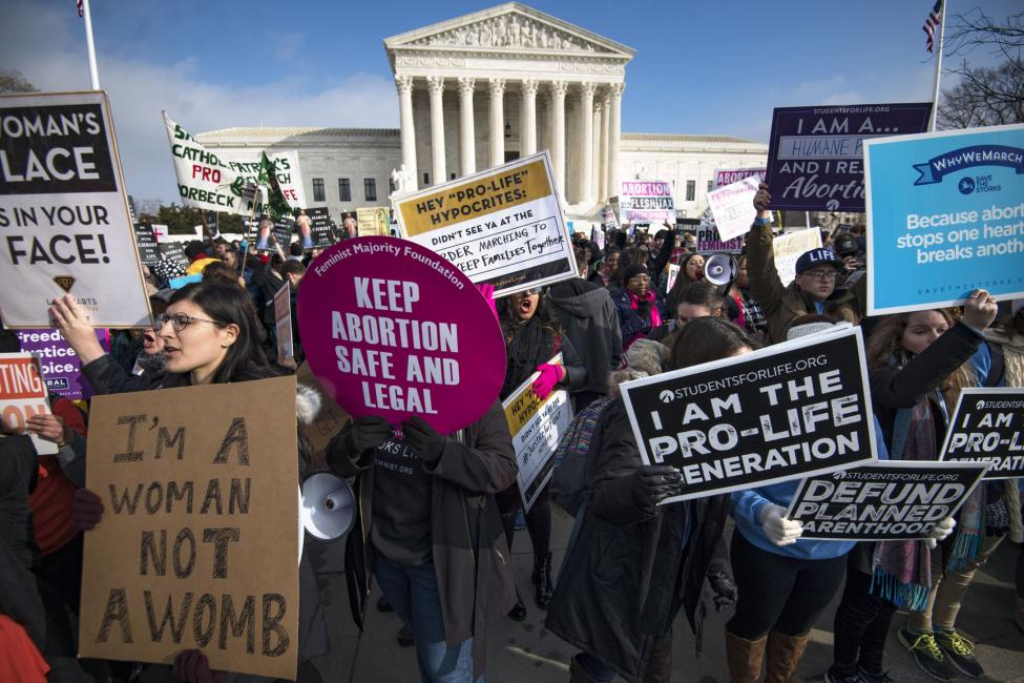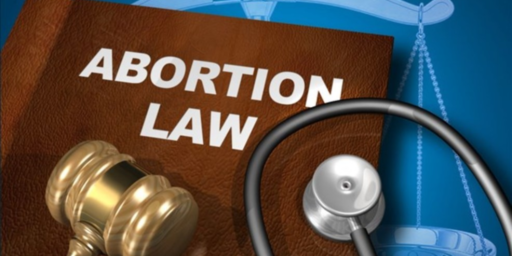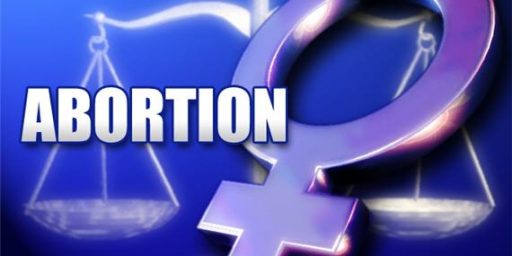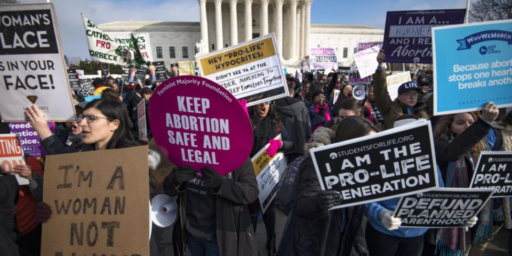Supreme Court Issues Split Ruling On Indiana Abortion Law But Sends A Signal
The Supreme Court sent a signal yesterday that seems to indicate how it might deal with future abortion law challenges and it doesn't bode well for pro-lifers.

Yesterday, the Supreme Court issued a split ruling on the appeal of a lawsuit against Indiana over a law signed into law by Mike Pence before he became President, upholding a portion of the law dealing with the disposal of fetal remains while keeping in place a ruling striking down a more controversial provision in the law:
WASHINGTON — The Supreme Court on Tuesday sidestepped part of a major abortion case, a new sign that the court is not yet moving aggressively to test the constitutional right to abortion established in Roe v. Wade.
In an apparent compromise in a case from Indiana, the justices turned down an appeal that asked the court to reinstate a state law banning abortions sought solely because of the sex or disability of a fetus. But the court upheld part of the same law requiring abortion providers to bury or cremate fetal remains.
The case, Box v. Planned Parenthood of Indiana and Kentucky, No. 18-483, had been closely watched because it could have given the Supreme Court its first chance to consider the constitutionality of a state law restricting abortion since Justice Brett M. Kavanaugh replaced Justice Anthony M. Kennedy last year.
Justice Kennedy had been a cautious supporter of abortion rights, while
Justice Kavanaugh’s limited record on the subject as an appeals court judge suggested some skepticism.
The modest move on Tuesday left for another day the consideration of state laws limiting abortion that were enacted, at least partly, to challenge Roe v. Wade. Such laws are being enacted at a brisk pace, including one in Alabama banning almost all abortions in the state, without exceptions for rape and incest, and others that bar the procedure after doctors can detect what the measures call a “fetal heartbeat,” which happens around six weeks of pregnancy.
The new laws are intended to give the Supreme Court an opportunity to reconsider Roe.
The court’s decision on Tuesday, issued without briefing on the merits or oral arguments, was unsigned and just three pages long. The court stressed that its decision on fetal remains was not a ruling about abortion rights.
In declining to hear an appeal on the law banning abortions sought for specific reasons, the court said it was expressing no views on the constitutionality of such laws. A split among lower courts is ordinarily required for Supreme Court review, and in this case, the court noted, there was no such disagreement.
Justices Ruth Bader Ginsburg and Sonia Sotomayor said they would have denied review of both issues in the case.
(…)
A three-judge panel of the United States Court of Appeals for the Seventh Circuit, in Chicago, unanimously struck down the provision limiting permissible reasons for having an abortion, though one judge said he did so reluctantly and only because he was bound by Supreme Court precedent.
In 1992, in Planned Parenthood v. Casey, the Supreme Court ruled that states may not prohibit abortions or place substantial obstacles in the way of women seeking them before fetal viability. Judge William J. Bauer, writing for the majority on the Seventh Circuit, said that ruling doomed the law’s restrictions.
“These provisions are far greater than a substantial obstacle; they are absolute prohibitions on abortions prior to viability, which the Supreme Court has clearly held cannot be imposed by the state,” he wrote in the decision issued by the appeals panel.
Judge Daniel A. Manion voted with the majority in that case, but did not adopt its reasoning. “Indiana has a compelling interest in attempting to prevent this type of private eugenics,” he wrote. “But the fact remains that Casey has plainly established an absolute right to have an abortion before viability.”
“That today’s outcome is compelled begs for the Supreme Court to reconsider Roe and Casey,” he wrote.
The Seventh Circuit panel had divided 2 to 1 on the part of the law concerning fetal remains. Judge Bauer, writing for the majority in that decision, said the distinctions in the law were not rational, noting that it allowed women to dispose of remains as they saw fit but required abortion providers to treat them largely as they did other human remains.
In dissent, Judge Manion wrote that Indiana was entitled to insist on “the dignified and humane disposal of the remains of unborn children.”
The full Seventh Circuit initially agreed to rehear the panel’s ruling on the fetal remains provision but later announced that it had deadlocked after a judge recused himself.
Before diving deep into this case, its important to point out exactly what the Supreme Court did here, and what it might signal about how it would handle abortion cases in the near future in the wake of the retirement of Anthony Kennedy and the confirmation of Brett Kavanaugh to replace him. The Indiana law was being challenged in two respects. The first challenge was to a provision of the law that barred abortions made on the basis of the gender of the fetus or the parent(s) having been informed that the fetus had some sort of deformity or disability, which apparently could include anything from a club foot to Down’s Syndrome or other genetic abnormalities that would impact the health or development of the fetus after birth. The second challenge was to a provision in the law that requires abortion providers to either bury or cremate fetal remains rather than disposing of them with other medical waste.
Taking the second challenge first, the Court essentially unanimously (with concurrences in part from Justices Thomas and Ginsburg) reversed the lower courts and upheld the regulation. In its ruling, the Court specifically stated that the ruling on this part of the law should not be taken as a ruling on abortion rights and was not intended to have an impact on the precedents established by Roe v. Wade and Planned Parenthood v Casey. and reaffirmed in Whole Women’s Health v. Hellerstadt et al, a case in which a 5-3 Supreme Court struck down a series of Texas laws that were clearly designed to make it difficult for abortion clinics to operate in the state. Instead, the Court, in an unsigned opinion that runs just three pages, found that the state had a legitimate interest in controlling how human remains are disposed of, even when those remains are those of a fetus aborted prior to being brought to term. In this respect, it is important to note that the law does not require the parent(s) of the fetus to bury or cremate the fetal remains, it simply regulates what the abortion clinic must do with respect to those remains after the abortion. The Justices also note that the law does not place any undue limitation on a woman’s right to have an abortion nor does it place any requirement to act on her. Essentially, the court viewed this provision of the law as a health regulation not unlike other regulations dealing with the disposal of human and animal remains.
On the first challenge, the Court declined to hear the appeal of the provision banning abortions for gender selection or to screen out genetic defects such as Down’s Syndrome. The most that can be said in this regard is that there were not four Justices who wanted to hear the appeal on this particular issue. In that respect, the Court’s opinion only addressed the second issue in a single paragraph:
Our opinion likewise expresses no view on the merits of the second question presented, i.e., whether Indiana may prohibit the knowing provision of sex-, race-, and disability selective abortions by abortion providers. Only the Seventh Circuit has thus far addressed this kind of law. We follow our ordinary practice of denying petitions insofar as
they raise legal issues that have not been considered by additional Courts of Appeals.
Beyond that, any discussion about what this might mean for the immediate future and how the Court might deal with challenges is arguably academic, but that’s not stopping pundits on both sides of the abortion issue from chiming in. For example, Ed Morrissey points out that if there were really four Justices that wanted to deal with the merits of the sex and disability selection portion of the law, they could have granted certiorari:
If four justices wanted to address this, it would have gotten cert regardless of scrupulosity about Rule 10. The rule itself states that it is “neither controlling nor fully measuring the Court’s discretion,” meaning that it’s a guideline rather than a “rule.” The Supreme Court can take a case directly from a district court if it sees fit to do so. They just aren’t inclined to address the fundamental questions abortion raises, and apparently aren’t terribly inclined to admit it either.
At best, this is a signal to lower courts for dissenting rulings that will provoke a Supreme Court review. Even if it is, the decision itself would counter much of that encouragement. The lack of enthusiasm for taking it up now doesn’t bode well for an eventual challenge on the issue of sex-selective abortions, let alone abortions in general.
(…)
This isn’t even a punt. It’s a pass, plain and simple. Maybe the court can’t avoid these issues forever, but this particular court certainly is in no hurry to take them up at all. And that bodes very ill for the flurry of pro-life legislation emerging from conservative states.
On the other side of the aisle, Anna North at Vox agrees with Morrissey’s conclusion about the signal that this sends about the odds that this Court will take up a full-fledged challenge to Roe and its progeny in the short term:
In addition to its impact on Indiana law, the decision signals that the Supreme Court may want to move slowly when it comes to the abortion issue.
Many of the abortion bans passed around the country in recent months — most notably an Alabama ban on abortions at any stage of pregnancy — have been designed to encourage the Court to revisit Roe v. Wade. But the Court doesn’t need a near-total ban on abortion to revisit Roe; nearly any case involving abortion rights could provide an opportunity for the justices to reconsider, and potentially overturn, the landmark abortion decision.
The Indiana abortion law, for instance, was in conflict with Roe because it prohibited some abortions — specifically, those performed because of sex, race, or fetal diagnosis — before a fetus can survive outside the womb. If the Court had decided to hear it, the justices could have chosen to overturn the entire Roe decision.
Advocates on both sides of the issue see Justice Brett Kavanaugh as a potential deciding vote to overturn Roe. But since the battle over his confirmation, including Christine Blasey Ford’s testimony that he sexually assaulted her when they were in high school, the Court has shown an unwillingness to take up the issue just yet.
Last December, for instance, the justices declined to hear two cases that could have allowed states to strip funding from Planned Parenthood. Though the cases did not involve abortion directly, many saw the decision as a signal that the Court wanted to wait before wading into the issue of reproductive rights.
Tuesday’s ruling is a sign that they’re still waiting.
As North goes on to note, though, there’s at least one Justice that doesn’t want to wait. Along with the short per curium opinion, Justice Thomas filed an extensive concurring opinion that agrees with the Court on the fetal remains portion of the law but dissents from the denial of review to the other part of the law. In that portion of his opinion, as Robert Barnes at The Washington Post and Tierney Sneed of Talking Points Memo both note, Thomas goes into a long discussion that bizarrely seeks to equate allowing abortion for the purpose of sex selection or preventing the birth of a deformed or disabled child with eugenics. The fact that Thomas was not joined in his opinion by any of the other conservative Justices, including either of President Trump’s nominees, seems to indicate that there is no mood on the Court to take this issue head-on. As Morrisey notes, this does not bode well for any hope that the Court will take up the appeals of more direct challenges to Roe such as the recently passed laws in Alabama, Louisiana, Mississippi, Missouri, Ohio, and Georgia.
Here’s the Court’s opinion, along with the Thomas and Ginsburg concurrences:
Box et al v. Planned Parent… by on Scribd





While I disagree with Thomas and thought the long diatribe was out of place, how is selectively aborting disabled children (or children of a particular race) not eugenics? There’s not a lot of evidence that this is a problem, least of all in Indiana (Thomas’ examples are drawn from other countries). Everyone knows the main purpose of the Indiana Law is to stop people aborting fetuses with Down’s Syndrome. But I don’t think calling that eugenics is completely out of line. At the very least, there is a moral quandary there (which is exactly why I prefer it to be outside the domain of law). And I think the angry response is because people don’t want to countenance that.
@Hal_10000:
What if science advances to the point that we could pre-screen a developing embryo in the very early stages of pregnancy and undo the genetic characteristics that would lead to Down’s Syndrome (thus allowing a child to develop to term, but not with Down’s Syndrome). Would that be eugenics?
Additionally, if you support the right to abortion as set forth in Roe and Casey then why is the reason for the abortion relevant at all?
@Hal_10000: Abortion can be used for eugenics, sure. I haven’t read the opinion, but the coverage of it I’ve seen says that the problem was that Thomas tried to lump all abortion and contraception in with the early 20th century eugenics movement. But like I said, I haven’t read it.
Really good coverage of the link between poorly-done biology and early 20th-century racism/eugenics movements in several chapters of this book, which is the best nonfiction i’ve read all year (so far).
@Doug Mataconis:
There’s an intense debate going on about exactly that thing, with the ongoing advancements in gene therapy and CRISPR. There are a lot of people who think it is. And a lot of people who see Iceland’s 99% Down’s abortion rate (cited by Thomas in the opinion) as extremely alarming.
I don’t think the reason is relevant. But I don’t think it’s unreasonable for people who are more skeptical of Roe to raise this issue.
@Teve: I did read the opinion. For the most part, it’s basically, “Well, the Indiana law addressed this so here’s me segueing to ten pages of pro-Life text about Sanger and eugenics.” Sanger’s affinity for eugenics is historically interesting. I’m not sure why it’s relevant to today’s debate. (OTOH, Roe itself had an excursion into abortion history too).
Guilt by association. I see creationists do it all the time. Darwin==Sanger, racism, eugenics, hitler, holocaust, etc. It’s garbage, but very powerful to people high on emotions and low on knowledge.
This is disingenuous; the Court can’t possibly not be aware that the two effects of this ruling are (1) to make abortion significantly more expensive (by raising the costs to the provider), and (2) to incrementally solidify the precedent that fetuses deserve the same treatment as people. The first will have an immediate chilling effect on abortion; the second tees up personhood-based rulings in the future.
@Hal_10000:
While I agree that selective abortion is a form of eugenics, fetuses are not children.
Eugenics has a deservedly bad name, but just because something could technically be called eugenics doesn’t mean it’s bad. If we could selectively filter embryos such that within a generation nobody ever had to have Tay-Sachs disease again, you could call that eugenics, but you’d also have to be a level-10 monster psychopath to prohibit it.
@Hal_10000:
And are inaccurate in describing them. They are apparently taken from a George Will column. What that says about the validity of Thomas’s argument is, I think, self explanatory.
I wonder how Indiana intended to prove the intentions of the woman in prosecuting such cases. It’s bad enough that someone would go investigate a miscarriage, but to start sorting out legal abortions from illegal ones – what does that “crime unit” look like?
@Joe: Law and Order: Stirrups Unit
@Teve:
Seconded for emphasis.
An inner pedant stands up with a question: If the definition of Eugenics is ‘the science of improving human populations by controlled breeding’ (as the ‘Bing’ version of Mr Google’s machine explains), does that mean that the purpose of the Indiana law was to ensure that there would be sufficient Down’s children born to guarantee a breeding population of them in that state? Does anyone know how Down’s kids happen?
I think that there’s a catagory error here. The purpose of the law was to keep fetus’ with Downs from being aborted and had NOTHING to do with “improving the human race”. IMHO Justice Thomas just launched into a strangely unrelated thread that sounded somehow similar.
The issue here (seems to this frequently befuddled old person) is that the fetus is a person-with-a-disability. And the Supreme’s response was to the ‘person’ part of that.
If there were actually a ‘pro-Eugenics’ basis for such a bill, I’d find that a major negative; no pregnant woman (and no young couple, either!) should be saddled with the responsibility of ‘improving the human race’ when they face such a devastating decision.
Edit: Having a memory of rather distant times, I recall that an original theory of the Anti-choice folks was ‘no decent woman would do such a thing without some evil influencer’. That made the non-enforcement of penalties for having an abortion seem right; those poor girls didn’t really want to kill their babies in the womb and they were misled. Then the statistics of the births of Downs kids took a huge nose dive. Accounting for that drove the Jesus Club crazy. As Justice Thomas is an example.
Eugenics is a smoke screen.
@Teve: Exactly! The problem and reputation of eugenics comes from the character, beliefs, actions, and goals of the people who have supported it.
@Hal_10000:
I get what you’re saying but if we could prevent people from being born with Down’s Syndrome, Tay-Sachs, or a whole host of other genetic abnormalities how is that a bad thing?
On the other hand, I do recognize the issues and implications of gene therapy. However, for better or worse the genie is out of the bottle and it is coming whether we like it or not.
Note —- I inadvertently forgot to embed a copy of the opinion (and concurrences from Thomas and Ginsburg( in the original post. They are now embedded at the end of the post for anyone interested.
@Doug Mataconis:
Oh, I agree. And I disagree with Thomas. I’m just arguing that Thomas’ opinion represent a lot of people’s thinking on this issue and isn’t that far out there. I don’t think it’s beyond the pale.
Unexpectedly, the best take yet on the Alabama law is at DuffelBlog.